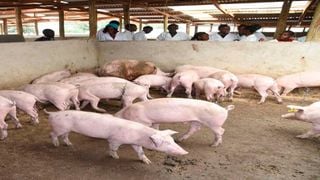
Agriculture students of the Eldoret Technical Training Institute during a practical lesson on pig farming at the institution’s practicum and demonstration farm in Kapsaret, Uasin Gishu County, on June 11, 2019.
| File | Nation Media GroupSeeds of Gold
Premium
Important qualities of a model pig farm
What you need to know:
- Healthy pigs do not get dirty if their environment is clean and feed is nutritionally balanced. However, pigs are experts in dirtying themselves if you provide them the opportunity.
Two weeks ago I had a dilemma of organising a farm tour for a pig keeper and two prospective farmers. Charles and Violet have never reared pigs but they wanted to start keeping pigs.
I had taken the two through pig farming separately at different times and each had told me they had pig farms they planned to visit to learn practically how the production is done.
They both called me later and asked if there was a farm I could recommend for them to see how pigs are kept in a clean environment and baconers that mature in six months.
They individually said the farms they had visited did not impress them on hygiene, cleanliness and baconer maturing standards.
Charles actually enquired whether it was possible to keep a pig clean and the farm free of the piggy smell. I told him he will find out the answer for himself when we visited a farm I would recommend.
I also agreed with both Charles and Violet that it would be good I accompany them on the visit because some of the questions they had were better demonstrated on the farm. Coincidentally, I also had Greg who had asked me to check for him a farm where he could obtain high quality breeding gilts for expansion of his pig farm.
I found the request opportune as I would also be able to show Greg that pigs can separate their dunging area and sleeping quarters. During my visit to Greg’s farm, I had found the pigs were dunging in both the sleeping area and the sunbathing section of the pen.
Under normal circumstances, pigs will dung in the wet area where the drinking point is and sleep in the feeding area, which remains dry. I have not yet figured out why Greg’s pigs have been violating that norm.
I had recommended the drinking area be kept wet to see if the pigs would change their toilet habits. They had not yet changed.
My first dilemma was that Greg is an experienced pig farmer while Charles and Violet are planning to start. My second issue was that organising two separate visits in quick succession would be inconveniencing to the host farm as training was not part of their business model.
Luckily, we had just discussed training with the farm owner and she was convinced that training and supplying breeding stock would add value to the farm’s business.
In livestock farming, one may decide to be a single product farmer or offer others depending on the livestock species. The products in pig farming are varied.
They include pork production that comes from suckling piglets for whole-carcass grilling, porkers, baconers and cull pigs. There are also weaner piglets, grower and finisher pigs. Finally, there are the breeding gilts and boars. The host farm has mainly been doing baconer pig production.
Also read: Boda boda members ride high with pig farm
I felt Greg could find it boring and time consuming to listen to all the questions the prospective pig farmers would be asking. Luckily, Greg is a patient man and he agreed to join the tour to save the farm valuable working time. He also opined that the questions from the prospective farmers could also be a learning opportunity for him.
We visited the farm last week and the tour turned out to be beneficial to all. Greg came with his manager who would select the gilts he wanted from the farm. He also came with his driver who would collect the selected gilts when their pregnancy became two months old. Achieng, the farm manager conducted the tour.
Charles’ questions on cleanliness and smell were answered right from the gate to the first baconer pens.
The pig house was very clean and there was barely any piggy smell. The animals were also very clean. He said he was impressed that pigs could keep themselves so clean.
I explained that pigs are very clean animals. Healthy pigs do not get dirty if their environment is clean and feed is nutritionally balanced. However, pigs are experts in dirtying themselves if you provide them the opportunity.
Well, that sounds like humans and corruption. Violet had wondered how to know pigs were on heat.
She could now see clearly that pigs on heat had reddened swollen vulvas. A lot of the knowledge acquired in farming involves observation and confirmation with authoritative literature or expert advice.
We finally reached the breeding gilts that were Greg’s category of interest. He assessed the animals and confirmed they met the conventional criteria for selecting breeding stock. They had good body proportions, all had at least 12 teats and their ham and shoulders were strong and well-rounded.
Their legs were strong and the hooves fit squarely on the concrete floor. I was impressed by Greg’s understanding of breeding pigs’ selection and passion for the animals. He assured Charles and Violet that they would get to his level as they progressed in their pig farming ventures as long as they were willing to keep learning.
At the end of the tour, Greg and the farm owner held an animated negotiation and agreed on a supply schedule for breeding gilts with a two-month-old pregnancy. Charles and Violet assured the owner they would return for breeding gilts once they had completed construction of their pig houses.





